Kajabi vs. Teachable: The Ultimate Side-by-Side Comparison
Jessica Glendinning
Updated by Tara Malone
Are you overwhelmed, trying to choose the right Learning Management System (LMS) for your online course?
When it comes to choosing a platform, today’s course creators are faced with too many options. Think about it. With high-quality choices, like Kajabi and Teachable, how do you decide what will work best for your course business?
If you’re just getting started on your course creation journey, your peers often haven’t used these platforms and can’t weigh in. And you don’t have the knowledge and expertise (yet) to know exactly what you’re looking for.
You can rely on reviews to tell you if the product is good, but not if it’s “the one” for you. So how can you simplify the process and make sure you’re making the right decision?
That’s where we come in. Today, we’re comparing two of the most popular platforms — from a course creator’s point of view.
Not in a Kajabi vs. Teachable: battle to the death, sort of way. 😉 But rather, Kajabi vs. Teachable: both good, but one will better suit your needs.
Here’s what to expect in this comparison:
Ready? Let’s get comparing!
Kajabi vs. Teachable: Price
Price is arguably one of the most important factors – and usually the first one – that aspiring course creators think about when choosing an LMS.
This makes sense, because the platform will only help you if it’s within your budget. At the end of the day, if you can’t afford a product, it may not be the one for you… yet.
Let’s take a detailed look at how the pricing compares between our two competitors.
Kajabi Pricing
Kajabi is the more expensive of the two, though that’s due to its more robust nature, marketing tools, and customizable options.
We’ve found that Kajabi’s pricing is a bit deceptive, because the cost includes a lot of features you would have to pay for separately with other platforms. When you do your comparison math, don’t forget to include those extras!
A 14-day free trial is available, but (unlike Teachable) they don’t offer a free long-term plan.
Here’s a look at monthly vs. annual pricing:
Pricing structure when you pay monthly:
- Basic: $1,788 ($149/month)
- Growth: $2,388 ($199/month)
- Pro: $4,788 ($399/month)
Pricing structure when you pay annually:
- Basic: $1,428 ($119/month)
- Growth: $1,908 ($159/month)
- Pro: $3,828 ($319/month)
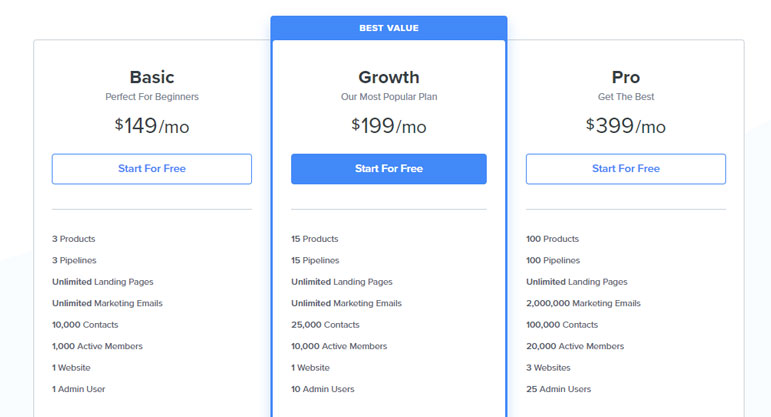
Teachable Pricing
Teachable is more budget-conscious. But remember, include the cost of any other marketing tools you might need to pay for separately in your comparison math.
Unlike Kajabi, Teachable offers an always-free plan.
Pricing structure when you pay monthly:
- Basic: $468 ($39/month)
- Professional: $1,188 ($99/month)
- Business: $5,988 ($499/month)
Pricing structure when you pay annually:
- Basic: $348 ($29/month)
- Professional: $948 ($79/month)
- Business: $4,788 ($399/month)
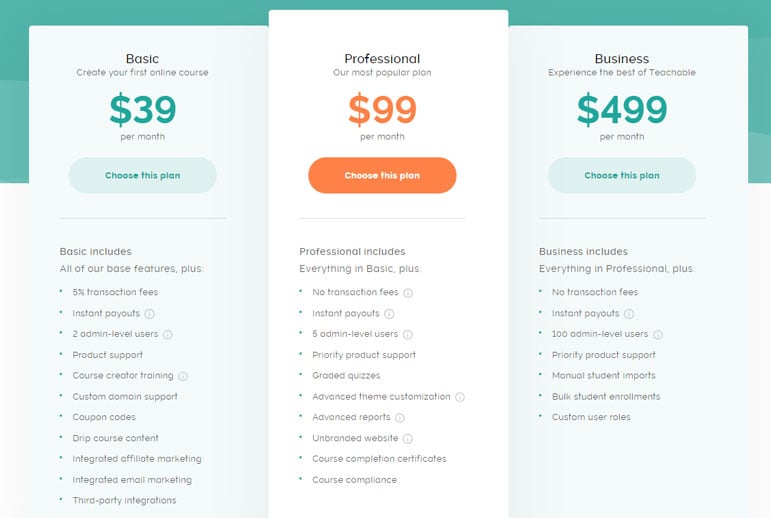
Now that you understand the pricing structure for both options, let’s move on and look at how to set up your first course.
Kajabi vs. Teachable: Course Setup
Course setup is another significant factor that sets these two apart.
Teachable is the better option for first-time course creators, whereas Kajabi is better for those who have experience. Lots of bells and whistles are great, but only if you have a use for them.
Let’s take a look at each platform’s setup process:
Kajabi Course Setup
Kajabi allows you to create a full website, including a blog, that is full of customizable options. You can tweak your website and lessons to design the exact course you have in mind.
This is great for those who have experience in course creation; but, if this is your first time, the complex features can be overwhelming.
Here’s a closer look at creating a basic course:
Step 1: Name your course.
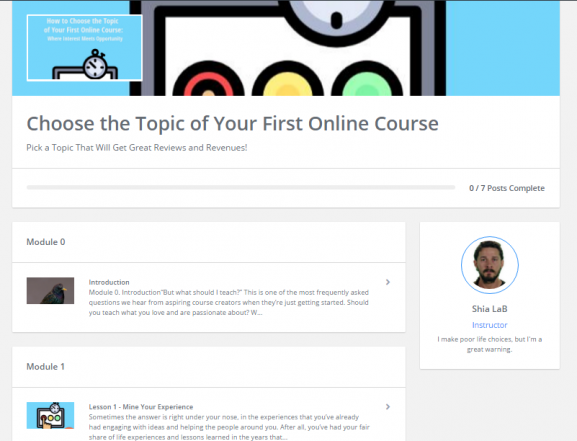
Step 2: Review your course dashboard.
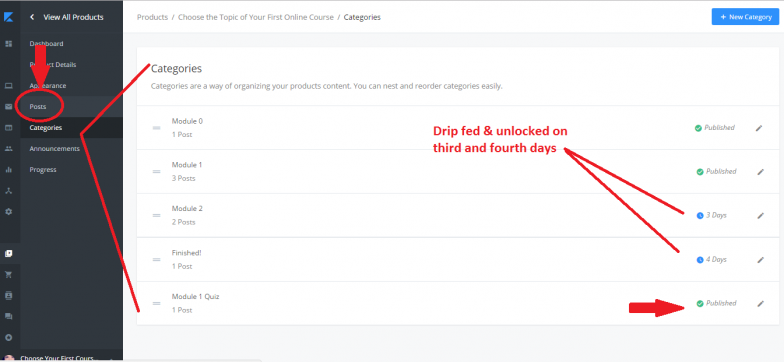
Step 3: Open each lesson to add media and other course details.
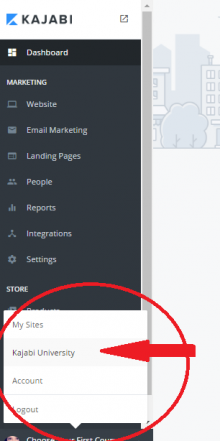
Step 4: Now you’re ready to create your first offer!
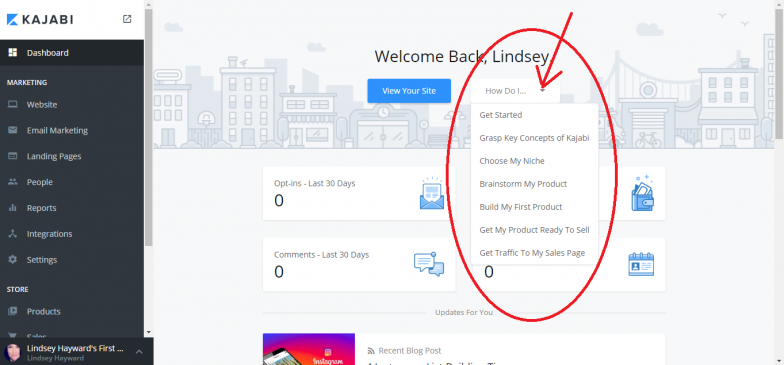
Step 5: Set up your marketing.
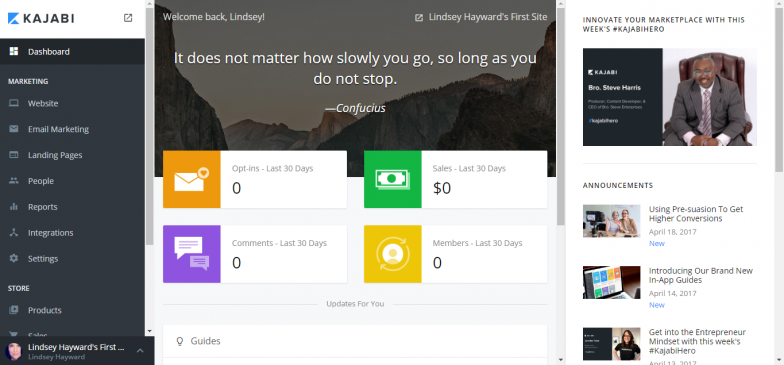
And your course is ready to go!
You’ll notice that Kajabi offers in-depth marketing tools that Teachable doesn’t. The platform even supports its own email marketing and pipeline creation.
Next, let’s peek under the hood at Teachable.
Teachable Course Setup
Unlike Kajabi, Teachable is perfect for the first-time course creator or the busy entrepreneur who doesn’t have time to learn a bunch of new tools.
The setup is easy to understand, fast, and intuitive. The process is a breeze to follow, and its site builder will help you create a professional-looking product.
Here’s a closer look:
Step 1: Name your school.
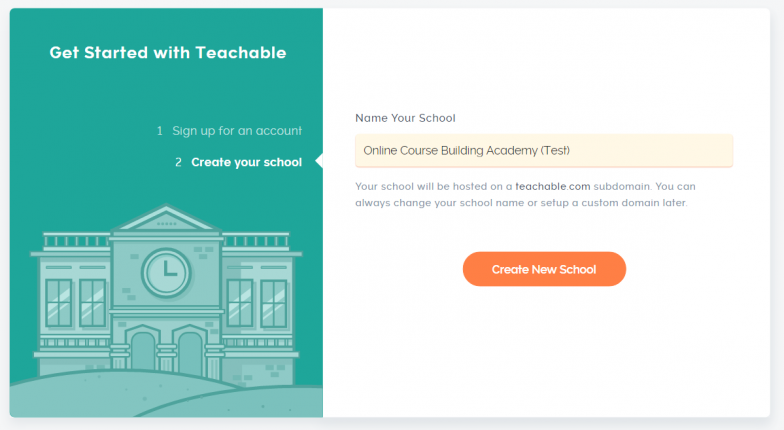
Step 2: Tell them more about you and your courses.

Step 3: Watch the tutorials and start course building.
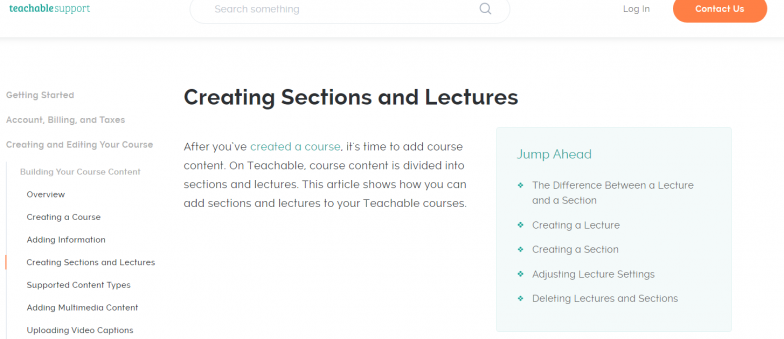
Step 4: Create your course.
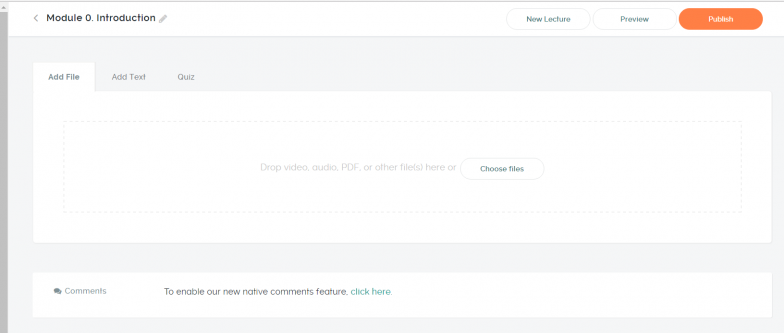
Step 5: Add your curriculum.

Step 6: Choose your pricing plan.
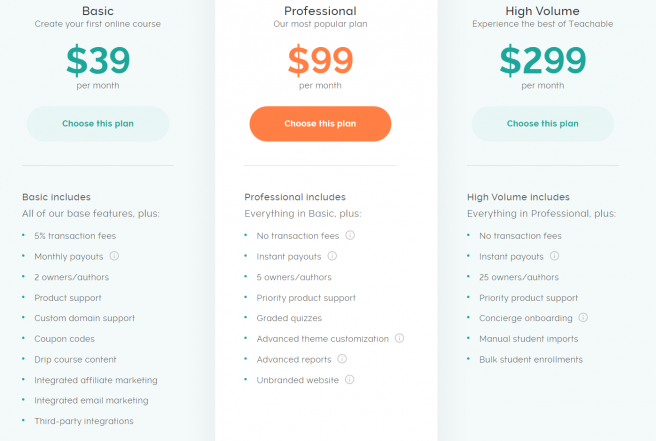
And now you’re ready to publish your course!
Pro tip: We highly recommend watching the tutorial videos. They’re easy to follow and will save you significant research time.
“Teachable is perfect for the first-time course creator or the busy entrepreneur who doesn’t have time to learn a bunch of new tools.”
Tweet Me
You’ve seen what the experience is like for you, the course creator. But, just as important, what is the experience like for your students?
Kajabi vs. Teachable: Student Experience
You’ve worked hard on creating content that your students can use to better themselves or their businesses.
It’s vital that they have a good experience while taking your course and achieve the results or outcomes your course promises.
Let’s continue our comparison, from the students’ perspective.
Kajabi Student Experience
Kajabi’s courses are exceptionally customizable, with over 10 themes to choose from.
The platform provides students with a well-rounded experience. They will have access to your website, blog, and engaging tools (like assignments—depending on your plan).
Next, let’s take a peek inside the Teachable platform, from the perspective of your students.
Teachable Student Experience
Teachable offers fewer custom options, but it does allow you to tailor your courses to other languages, in case you’re interested in attracting an international audience.
The landing page for your school is very visual, to catch your students’ attention.
And here’s what your students see when they open their course.

But I think we all know that making your decision requires more information. Let’s look at a few other considerations.
4 Key Points to Consider
There are a few other features you might want to consider when choosing which platform is the best fit.
1. How many students will you teach?
Kajabi’s numbers are based on which plan you choose.
- Basic: 3 courses and 1,000 active students
- Growth: 15 courses and 10,000 active students
- Pro: 100 courses and 20,000 active students
Teachable offers unlimited courses and students across the board, even on the free plan.
2. What email service provider do you use?
Kajabi integrates with most major email service providers, including MailChimp, Drip, ConvertKit, Segment, ActiveCampaign, ClickFunnels, and Aweber. Kajabi also supports its own email platform.
Teachable also integrates with many email service providers, such as MailChimo, Aweber, and ConvertKit. You can also use a service called Zapier to integrate with your email service provider.
3. What payment processor do you use?
Kajabi uses Stripe and PayPal to process payments.
Teachable uses Stripe, PayPal, and Google/Apple Pay. The platform also offers a native payment gateway called Teachable:pay, which allows creators to accept student payments and then receive payouts on a set schedule.
4. Are your students mobile?
Teachable offers an app for iPhone users to learn on the go, and Kajabi has an app as well.
“Kajabi offers a great selection of course features and student engagement tools to make your students’ experience one of a kind.”
Tweet Me
Now that you’ve seen the breakdown, it’s time to choose.
Teachable vs. Kajabi: Which one is right for you?
Kajabi is better for course creators who have created courses in the past and are looking for a flexible, customizable platform.
Kajabi offers a great selection of course features and student engagement tools to make your students’ experience one of a kind. This platform is an overall hearty, flexible tool in a student-friendly package.
Teachable is better for course creators who are busy entrepreneurs building a course for the first time.
Teachable works best for users who prefer an easy setup without extensive research. The platform is straightforward, with a variety of options that will fit any course type. Its lower prices suit a smaller budget, and its top-notch tutorial videos make this one ideal for first-time users.
Whichever platform you choose, it’s time to start building your course! You have valuable information to share. Don’t keep your students waiting!
And if you want to take the guesswork out of what it takes to create a successful online course, you are invited to join our free Hybrid Courses Bootcamp!
Let’s Start Building Your Online Course!
In our FREE Hybrid Courses Bootcamp, we’ll walk you through how to transform your knowledge and expertise into a profitable online course… one your students will love.
Catherine
Hello! Just a friendly FYI that Kajabi does have an app that students can use to view their courses. When they add the app they can also see courses from any other instructors that use Kajabi.
~Catherine Dove
Tara Malone
Thanks so much for letting us know, Catherine!
Vonnie Hudson
Jessica, great article. Here’s my two-cents…
I got inspired to start my own online business about 12 years ago while working at a New York City internet startup in the heart of Times Square. I was the Director of Information Technology but I sat directly across from the CEO which was amazing because I got to hear the inside scoop on how the business was being run, how profits and losses were managed and the overall strategy of running an online business.
I started a tech blog back in the 2012, connected it to Google Adsense and started earning money by amassing massive clicks. It honestly blew my mind that I could earn real money from just ad clicks. The only negative side was that I needed tons of clicks to make anything substantial. So I read every blog post I could about SEO, I purchased all the top rated books from Amazon and started making relationships online, shared my site via social media and after four months I was making significant money.
In fact, after about nine months of soul torture, Google Analytics was telling me my site was pulling in half a million unique visitors per month and I was earning four figures based on ad clicks! I felt so blessed. So lucky. It was amazing… but it was soul torture. I can’t even begin to tell you how much work I had to put into that damn blog to even make amount.
So what did I do? I started binge listening to everything from Pat Flynn, to Amy Porterfield. I brought all the courses I could afford. I attended Jeff Walker’s training, Yaro Starak’s training and Ramit Sethi’s training. I listened to hours and hours of podcasts from Rick Mullready and Russell Brunson. It was a huge overload for me but I kept going. I brought Ryan Levesque’s “Ask Method” book, read it three times… I did it all.
And then I tried my hand at build an online business. I knew ads wasn’t the smart method because it took too long to blog. Blogging was a full time grind and as a married man with a little one and a full-time job, I didn’t have the time of day (or time of night) to blog.
So I signed up for ConvertKit, Aweber, Ontraport, ActiveCampaign, NewKajabi, Teachable and a whole bunch of other online platforms. I started selling courses on Udemy and I was started to earn some significant income again as I learned how to separate my time from my business by using automated systems.
After spending hours with support for all these online platforms I settled on New Kajabi because of one reason: their customer support team is freaking amazing. I cannot gush enough about how helpful they have been in helping me build my online business (not to mention generous as they upgraded my account
on several occasions) Yes, the tool is simple to use, yes they have tons of integrations, yes they host your website, handling payments, and funnels and launches and all that. But their support team.. there is quite honestly nothing like it.
Jessica Glendinning
Wow. Thank you for this amazing first-hand review, Vonnie! It sounds like you’ve really done the work through the years, and we really appreciate you taking the time to leave such a detailed review. I know that our readers will get a lot from your comment!
Jide
Thanks for sharing, Vonnie. This resonates with me as I also lead teams in the Information Technology space, and I am a die-hard entrepreneur on the side. Looking to set up an LMS, and pleased to see your feedback about Kajabi’s support team. Might just tilt me towards subscribing to that white-label provider
Stephen
This post was done with me in mind I am sure. Thanks Jessica…
Jessica Glendinning
Glad it was helpful, Stephen!